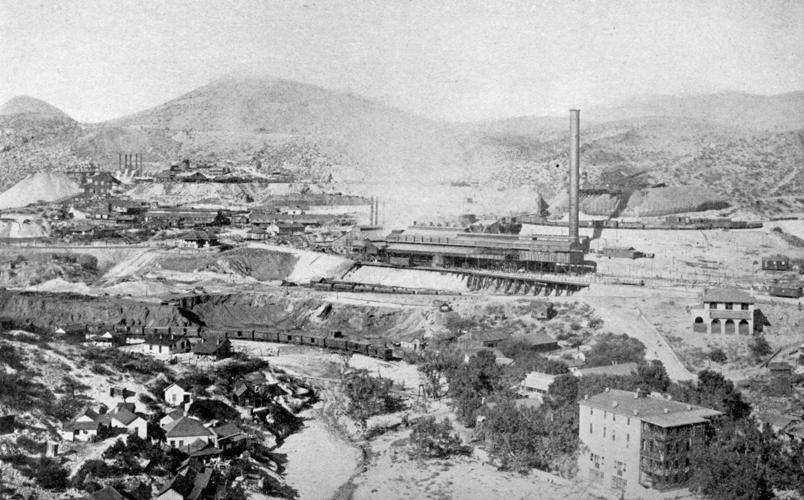Beginning in 1881, the Old Dominion Copper Mining Co. played a dominant role in mining operations around Globe.
Having merged with the Old Globe Copper Co., it soon acquired the original Globe Ledge claims once owned by Ben Reagan, one of the mine’s original discovers, who also held interest in the nearby Silver King Mine. The Globe Ledge claims, including the Alice and Interloper at the southeastern base of Buffalo Hill, later became known as the Old Dominion Mine — named after Virginia, home state of the wife of one of the original prospectors.
The Old Dominion vein was estimated as running 3 miles, striking northeast, with rich copper ore — some parts averaging as high as 20 percent copper. The mine would soon become one of the greatest suppliers of copper ore in the Globe-Miami Mining district.
Operations around 1881 included a small furnace one mile west of the future town of Miami. Emphasis was placed on copper silicate ore from a small schist deposit. Proving unprofitable, the smelting operation was relocated to Globe, with upgrades including two operational 30-ton furnaces in 1884. Several decades elapsed, which included reorganization as the Old Dominion Copper Mining and Smelting Co. in 1895, the arrival of the railroad in 1898 and a smelter upgraded to a daily capacity of 2,400 tons.
In 1904 Phelps Dodge controlled the majority of company stock in the Old Dominion Co. with James Douglas as its president. Dr. Louis D. Ricketts became general manager at the mine site. Ricketts had a background in modernizing plant equipment; these improvements enabled less costly operations. The Old Dominion Mine paid its first dividends in 1907.
By 1908, $2.5 million had been invested in the modernization of the Old Dominion Co.’s refining works. This included building six new furnaces at the smelter, enabling a monthly capacity of processing 3 million pounds of copper.
The mine was serviced with pumps capable of pumping 10 million gallons of water daily for municipal use at Globe and Miami, along with 22 cubic foot capacity tramcars. The Old Dominion Railroad included a Porter locomotive and 50-ton ore cars connected the mine, mill and smelter.
The town of Globe saw its greatest growth during the first decade of the 20th century based upon the success of the Old Dominion Mine as smaller businesses in town thrived. However, the town faced challenges including a flood during the summer of 1904 when Pinal Creek overflowed its banks.
The Old Dominion Mine also faced a series of setbacks, including a fire that occurred in the Interloper Shaft, claiming the life of three miners from asphyxiation, along with cave-ins. A mine strike in 1917 initiated by the Industrial Workers of the World (IWW) also took its toll on production, and four units of the Seventeenth United States Cavalry from Douglas were sent in to defuse the situation.
Postwar challenges including decreasing ore grades, from 5 percent copper to less than 2.5 percent; aging equipment; and flooding. The smelter closed in 1924 when the International Smelter at Miami assumed processing the mine’s concentrates.
It is estimated that the mine produced 800 million pounds of copper, bringing returns valued at $134 million, prior to its closure in 1931 when the Old Dominion Copper Mining and Smelting Co. succumbed to the challenges wrought by the Great Depression.
In 1940, the mine was acquired by Miami Copper Co. for $100,000. Water was pumped out of the mine to supply the company’s mining operations at Castle Dome, Copper Cities and Miami. Mining operations have occurred at the Old Dominion Mine since, including the open pit mining of hematite by lessee B.J. Cecil Trucking Inc. for the Portland Cement Co. at Rillito in the 1970s and ’80s.
The Old Dominion mine site today functions as a historic mine park and the only self-guided mine tour in Arizona where visitors can view old mining equipment, concrete foundations, excavations and interpretive plaques. It also provides a source of water to the Pinto Valley open pit copper mine operated by Capstone Mining Corp. five miles west of Globe. The foundation of the smelter built in 1906 can still be seen from the Globe-Miami highway.






